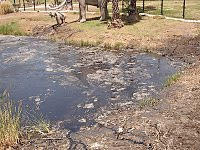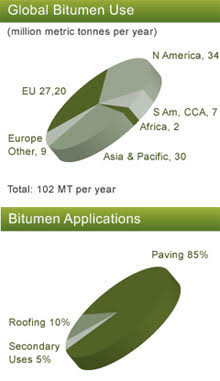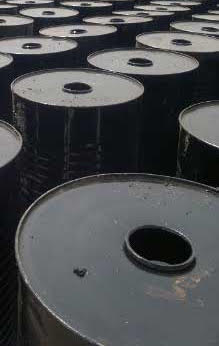Bitumen

Bitumen is a product of Crude oil Distillation. It is a semi-solid hydrocarbon product produced by removing the lighter fractions (such as liquid petroleum gas, petrol and diesel) from heavy crude oil during the refining process. As such, it is correctly known as refined bitumen.
“asphalt cement” or “asphalt”
In North America, bitumen is commonly known as “asphalt cement” or “asphalt”. While elsewhere, “asphalt” is the term used for a mixture of small stones, sand, filler and bitumen, which is used as a road paving material. The asphalt mixture contains approximately 5% bitumen. At ambient temperatures bitumen is a stable, semi-solid substance.
History of Bitumen

The Sumerians also used it as early as the third millennium BCE in statuary, mortaring brick walls, waterproofing baths and drains, in stair treads, and for shipbuilding. Other cultures such as Babylon, India, Persia, Egypt, and ancient Greece and Rome continued these uses, and in several cases the bitumen has continued to hold components securely together to this day. In some versions of the Book of Genesis in the Bible, the name of the substance used to bind the bricks of the Tower of Babel is translated as bitumen. Although its existence has not been confirmed, a one-kilometer tunnel beneath the river Euphrates at Babylon in the time of Queen Semiramis (ca. 700 B.C.) was reportedly constructed of burnt bricks covered with bitumen as a waterproofing agent.The term bitumen comes from Latin. The Greek name for the substance was ?σφαλτος (asphaltos). Approximately 40 A.D. Dioscorides described production of asphaltos (as distinguished from piss asphalt and naphtha): (1655 Goodyear translation). The terms asphalt and bitumen are often used interchangeably to mean both natural and manufactured forms of the substance.
"The Judaicum Bitumen is better than others; that is reckoned the best, which doth shine like purple, being of a strong scent & weighty, but the black and fowle is naught for it is adulterated with Pitch mixed with it. It grows in Phoenice also, and in Sidon, & in Babylon, & in Zacynthum. It is found also moist swimming upon wells in the countries of the Argentines of Sicily, which they use for lamps instead of oyle, and which they call falsely Sicilian oyle, for it is a kind of most Bitumen.
The Judaicum Bitumen is a famous deposit of native asphalt seeping through diapirs at the bottom of the Dead Sea, which comes occasionally to the surface through seismic activity in blocks of up to 100 tons in weight which are more than 99.99% pure. It was the object of the first known battle for a hydrocarbon deposit, between the Seleucids and the Nabateans in 312 B.C.
Geological origin of Bitumen

Naturally occurring deposits of bitumen are formed from the remains of ancient, microscopic algae and other once-living things. When these organisms died, their remains were deposited in the mud on the bottom of the ocean or lake where they lived.
Under the heat and pressure of burial deep in the earth, the remains were transformed into materials such as bitumen, kerogen, or petroleum. Deposits at the La Brea Tar Pits are an example.There are structural similarities between bitumen and the organic matter in carbonaceous meteorites.
However, detailed studies have shown these materials to be distinct.Given that analogous matter is found in certain meteorites and bitumen are also found in Archean rocks it is possible that some bitumen are primordial material formed during accretion of the Earth and reworked by bacteria that consume hydrocarbons.
Bitumen Applications

Known for its adhesive and cohesive assets, bitumen is mostly utilised in the construction industry. Bitumen is applied on road paving because it is viscous when hot, but solid once it cools down. Therefore Bitumen operates as the binder/glue for pieces of the aggregate.
The vast majority of refined bitumen is used in construction: primarily as a constituent of products used in paving and roofing applications. According to the requirements of the end use bitumen is produced to specification. This is achieved either by refining process or blending.
It is estimated that the current world use of bitumen is approximately 102 million tonnes per year. Approximately 85% of all the bitumen produced is used as the binder in asphalt for roads.

Bitumen is applied in construction and maintenance of :
In order realize the complexity of bitumen as a product an in-depth knowledge and detailed understanding for one of the way the roads are built is crucial. Specialists in bitumen know bitumen as an advanced and complex construction material, not as a mere by-product of the oil refining process. The ultimate paving material (also referred to hot mix asphalt concrete – HMAC or HMA) consists of about 93 – 97% mineral aggregate (stone), sand and filler. The remaining percentage is bitumen.
Bitumen Production Process
Of the wide variety of crude oils commercially available, only a limited number are considered suitable for producing bitumen of the required quality in commercial quantities. In general, these are heavy crude oils with a high sulphur content. In modern, integrated refineries, it is common practice to blend multiple crude oils to produce consistent quality high grade bitumen that meets precise engineering specifications.
Production processes
Residues from the distillation of meticulously selected crude oils provide the base materials for bitumen production. Bitumen refining separates the lighter fractions from the residues. Several manufacturing methods are used to produce specification bitumens depending on the crude source and processing capabilities available. Often a combination of processes is selected. The illustration shows a compilation of the main refinery processes employed.

DISTILLATION
The most common refining process is straight reduction from crude or a crude blend, using atmospheric and vacuum distillation. In the diagram, atmospheric distillation is used to separate lighter petrochemical and fuel fractions from the non-boiling component at the bottom, known as an atmospheric residue. The lighter fractions, such as gas oil and fuel oils are fed to other refinery units. The atmospheric residue is retained for bitumen. To remove the last traces of the lighter fractions and avoid heat transformation of the molecules, the atmospheric residue is introduced into a vacuum distillation unit, here the pressure reduction lowers boiling temperatures and unwanted thermal cracking of the molecules can be avoided.
SOLVENT DE-ASPHALTING
Specific solvents can also be used to separate the lubricant and bitumen components of crude, without damaging their chemical structure. According to the solvent used – propane or butane – different categories of bitumen can be obtained. Along with finely controlled variations in the vacuum distillation process, these processes permit the production of bitumens with varying levels of penetration. This property and the softening point are the two fundamental defining characteristics of bitumens produced to engineering specifications. Further key physical properties are sensitivity to temperature and ageing, cohesion and elasticity, all of which are measured by precise tests.
OXIDATION
Bitumen can be further processed by blowing air through it at elevated temperatures (280°C on average) to alter its physical properties for commercial applications.
Oxidised bitumen covers two distinct types depending on the degree of oxidation: air rectified and oxidised. Oxidised bitumen has a distinctive consistency at room temperature and a rubbery nature which affects how it responds to stress, or imprint. The process of oxidation increases the stiffness and softening point of the bitumen and considerably alters key physical properties. Varying the length of the oxidation or air blowing process varies the extent of the reaction and produces distinctive end products. Oxidised bitumen is used in roofing applications, while air rectified bitumen is used in paving applications and some roofing applications.
BLENDING
The final bitumen product can be produced to technical specification either directly in the refining process or by blending bitumens with different physical properties. Blending of higher and lower viscosity residues in the required proportions may take place at the refinery, at terminals or at a third party facility, where blend components and finished products can be easily transported and distributed for use.
Bitumen standards & Grades

Most Commonly Used Bitumen Specifications
Standard Petroleum Bitumen Grades
Polymer Modified Bitumen
Bitumen Emulsions
Cutback Bitumen
Types of Bitumen
PENETRATION GRADE
ASTM D 946 - 40/50, 60/70, 80/100
BS EN 12591 - 35/50, 50/70, 70/100
VISCOSITY GRADE
ASTM D3381-09 - AC10, AC20, AC30, AC40
IS 73:2013 - VG10, VG20, VG30, VG 40
PERFORMANCE GRADE
PG bitumen is bitumen which is graded based on its performance at different temperatures.
NATURAL BITUMEN OR GILSONITE
Gilsonite in mass is a shiny, black substance, brittle and can be easily crushed into a dark brown powder
BITUMEN EMULSION
Cationic Rapid Setting - CRS-1, CRS-2
Cationic Medium Setting - CMS-2
Cationic Slow Setting - CSS-1, CSS-1h
CUTBACK BITUMEN
Slow Curing - SC-70, SC-250, SC-800, SC-3000
Medium Curing - MC-30, MC-70, MC-250, MC-800, MC-3000
Rapid Curing - RC-70, RC-250, RC-800, RC-3000
Based on the generation source bitumen can be classified into three categories: natural, petroleum asphalts, coal tar pitches:
1. Natural bitumens or native asphalts are a class of bitumens which have been naturally produced due to climate conditions in the course of time, and are used without the need to be processed in distillation ways; they are very varied regarding their composition and properties.
2. Coal tar Pitches are hard black substances which are formed as the result of coal tar distillation. Their new broken surface is shiny and when they are heated they , along with fast decrease in viscosity, melt and their melting point depends on the production process.
3. Petroleum Asphalts/Bitumens are the bitumens which are derived from petroleum .These are solid and semi solid bitumens which are directly produced through distillation from petroleum or by additional operations such as air blowing. Compared with the other types, they are more commonly used and have more applications.

Types of Bitumen based on their applications
Based on their applications, bitumens can be divided into two groups:
1. Road construction or thin bitumen
2. Building bitumen (roof insulator) or hard bitumen About 90% of the produced bitumen is used in road construction activities and 10% of it is used for insulation applications. The main part of bitumen is used in the road construction activities and by the municipalities for coating the streets. Road construction bitumen is usually classified according to its penetration. The penetration rate of bitumen material represents its strength and hardness which is defined as the number of penetration unit (one tenth millimeter) of one vertical standard needle in one bitumen sample, in certain time and weight on the needle and temperature. The penetration rate of bitumen is usually measured 25 degree centigrade with 100 gram weight and in 5 seconds. Road construction bitumens made in Iran are “60 to 70” and ’85 to 100”. The numbers represent the range of bitumen penetration rate. Bitumen is hydrocarbon substance which is black to dark brown and quite solvable in carbon sulfur. It is solid in normal environment temperature but in increased temperature it first becomes paste and then liquid. It has two important properties, impenetrable against water and adhesiveness which makes it an important material for application.
Packing & Logistics
PACKING

DRUMS PACKING

POLYBAG PACKING

BULK SHIPMENT

BITUTAINER
Bitumen Packing Comparison
 |
 |
 |
|
|---|---|---|---|
| BULK SHIPMENTS (Bitumen Vessel – Terminal – Tanker) | Used (or) New Drums | Poly Bags | |
| Shipping Method | Special Bitumen Vessels – Heated Cargo | Standard Shipping Containers 18MT-20MT per Container | Standard Shipping Container 20mt per container |
| Shipping Availability/Reliability | Limited availability, cyclical supply | Excellent | Excellent |
| Shipping Cost | Expensive, freights vary with demand, difficult to budget for long term projects. | Affordable | Affordable |
| Storage | Extremely capital intensive in bulk terminals, high operating costs, major overheads | Standard Warehouses or directly on site | Standard Warehouses or directly on site |
| Handling | Bulk road tankers to deliver directly on site. Expensive but swift. | Forklifts, 5-6 drums/mt. Used Drums can leak. New drums if mishandled may break as well. Damaged drums that do not break will become difficult to decant. | 3.5ton Fork lifts can handle 2 x 1mt bags at a time. All bags double slinged and self-stabilizing. Can go straight from container to Melter in one move. Highly efficient handling. |
| Ground Transport | Expensive Bitumen Tankers – cargo continuously heated. | Standard trailers, can visit remote locations in smaller flat beds as well.Cheap and affordable. | Standard trailers, can visit remote locations in smaller flat beds as well.Cheap and affordable. |
| Wastage | Certain revolving %age will always remain in the vessel, terminal tank and road tanker. A direct loss. | 3-5% is always left in the drum and is wasted. | Inner lining is completely consumable. 100% of transported cargo is consumed. |
| Decanting / Melting | Product is always in liquid state, easy and immediate decanting. | Each drum has to be cut open (often manually). This is an arduous and inefficient task. Messy and often product is left behind in the drum. | Simple. Outer bag is cut away and the inner lining and cargo is melted in one go. |
| Environmental Impact | Large carbon footprint for entire supply chain as energy is used to keep the cargo heated throughout. | Very Poor as a steel drum has to be produced for just 160 – 180kg of bitumen. A 1000mt project results in 5000+ empty drums to be disposed of. The used drums will have bitumen residue that will inevitably pollute the ground and storage/scrap | Inner lining is 100% consumable and outer lining is 100% recyclable. |
| Other Points | Expensive, large carbon footprint and huge capital needs to be invested into a distribution chain that should be obsolete by now. | Old drums could cross contaminate the bitumen.New Drums are expensive. | Triple layered technology and an outer woven polypropylene bag ensures chance of leakage is negated. |

